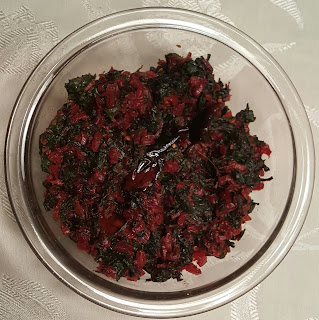Beetroot - yet another vegetable where you can eat the root, the stem and the leaves. Have never seen the flowers but I am sure I would find a way to cook and eat them too. This here, is a recipe from my childhood days that Mom used to make. I loved having it with steamed rice and a dollop of desi ghee (sound familiar 😲 right ? 😲) on top.
Here it has been prepared in an onion (2 medium sized) and garlic (10 cloves) puree which is fried (bhuno-ed) in ghee, and then further sauteed for 5 minutes with turmeric, cayenne powder and coriander powder. Add the chopped stems, stir 2-3 minutes, then add the grated beetroot and cook for 15-20 minutes till tender. Add the chopped leaves, salt and cook another 5 minutes. Sprinkle garam masala and chopped coriander leaves and serve with rice. Can also be enjoyed with wholewheat roti (flatbread)
Here it has been prepared in an onion (2 medium sized) and garlic (10 cloves) puree which is fried (bhuno-ed) in ghee, and then further sauteed for 5 minutes with turmeric, cayenne powder and coriander powder. Add the chopped stems, stir 2-3 minutes, then add the grated beetroot and cook for 15-20 minutes till tender. Add the chopped leaves, salt and cook another 5 minutes. Sprinkle garam masala and chopped coriander leaves and serve with rice. Can also be enjoyed with wholewheat roti (flatbread)

















































